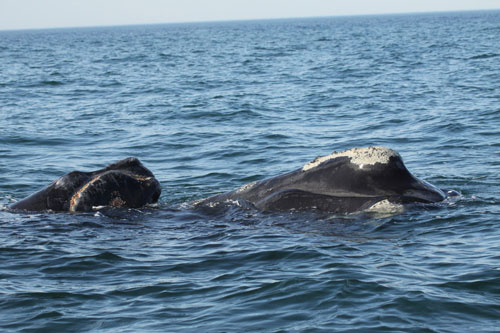Female North Atlantic Right Whales Produce Gunshot Sounds
Edmund Gerstein – gerstein2@aol.com
Charles E. Schmidt College of Science
Department of Psychology
777 Glades Road
Florida Atlantic University
Boca Raton, Florida 33486
Vasilis Trygonis
University of the Aegean
Lesvos Island, Greece
Steven McCulloch
Florida Atlantic University / Harbor Branch Oceanographic Institute
Fort Pierce, FL 34946
James Moir
Florida Marine Resources Council
Stuart, FL 32905
Scott Kraus
Edgerton Research Laboratory
New England Aquarium, Boston, MA 02110
Popular version of paper 4pAB13 presented at the 2014 167th ASA Meeting in Providence, RI.
Back to all Lay Language papers
Sound File 1. Typical gunshot sound recorded from a male in a surface active group in the southeast critical habitat (note the 191dB peak amplitude)


The spectral and temporal characteristics of these female gunshots resemble those attributed to adult males in the Bay of Fundy (Parks et.al., 2005) and those recorded from surface active groups in the southeast critical calving habitat (Trygonis et.al., 2013). However, the (female) gunshot calls are orders of magnitude quieter (-30dB). (Figures 3, 4, & 5).

Figure 3. Gunshot from adult male in surface active group (note 191 peak power dB)

Figure 4. Gunshot from female with calf (note 158 peak power dB)

Figure 5. Gunshot from female with calf (note 147 peak power dB)
The social and behavioral context of these gunshot calls naturally precludes any reproductive function or specific communication signaling by the female toward any individuals other than her calf. Synchronized underwater acoustic and surface video recording presented below chronicled gunshots and behavior as a mother interacted with a surface buoy in the forward path of her and the calf (Video file 1).
Video file 1. Mother approaches recording buoy, note how she does not avoid the buoy, but actively pushes it with her head and clears a path for her calf to follow. The event is accompanied with two gunshots as she interacts with the gear.
The behavior exhibited during this chance encounter offers an insight into how and when a whale (mother in this case) might interact with surface gear (fishing floats, as well as buoys), and suggests that gunshots may also be emotive indicators of heightened stress and agitation caused by anthropogenic factors, as well as naturally occurring social behavior.
References:
Parks, S. E., Hamilton, P. K., Kraus, S. D., and Tyack, P. L. (2005). “The gunshot sound produced by male North Atlantic right whales (Eubalaena glacialis) and its potential function in reproductive advertisement,” Mar. Mamm. Sci. 21, 458–475.
Trygonis V., Gerstein E.. Moir, J., & McCulloch, S. (2013). “Vocalization characteristics of North Atlantic right whale surface active groups in the calving habitat, southeastern United States,” J.Acoust. Soc. Am. 134, 4513-4531.
